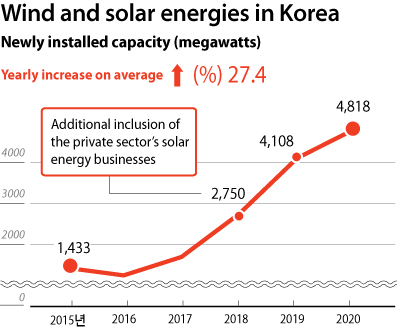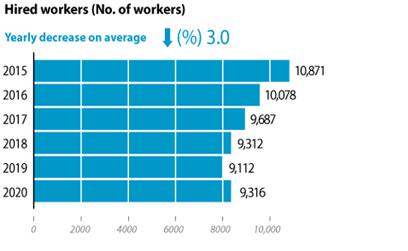Korea focuses on renewables but falls short against competition
![Solar panels are seen at a solar power plant in Yeongam, South Jeolla. [HYOSUNG GROUP]](https://koreajoongangdaily.joins.com/data/photo/2022/10/11/4962cdf4-dfa9-4884-9e18-b39cb9aec517.jpg)
Solar panels are seen at a solar power plant in Yeongam, South Jeolla. [HYOSUNG GROUP]
Korea has been shifting its focus to renewable energies, but data shows the country’s competitiveness is consistently falling as the industry's hired workers and sales drop.
Korea’s renewable energy capacity rose almost threefold to 4,818 megawatts in 2020 from 1,696 megawatts in 2017, the first year of the Moon Jae-in administration, according to Korea Energy Agency (KEA)’s data submitted to People Power Party (PPP) Rep. Yang Kum-hee's office on Monday.

Since 2015, the figure rose an average of 27.4 percent every year. But the number of workers in the related industry is going otherwise, decreasing by an average of 3 percent every year since 2015.
The number of newly hired workers related to renewable energies was 9,316 in 2020, up 204 compared to the previous year, but lower than the 9,687 recorded in 2017.

Sales related to renewables also dropped an average of 2.1 percent every year since 2015.
Sales in the wind power sector increased an average of 6.4 percent every year, but the constant decline of those for solar power, which takes up the majority energy share in renewables, led the fall.

The drop in the figure was largely due to major parts being replaced with those manufactured in China. Cheap parts produced in China caused a drop in Korea's market share and its exports for renewable companies.
The market share for Korean solar modules in the country rose to 78.4 percent in 2019, but dropped to 66 percent last year. During the same period, the market share of Chinese solar modules increased from 21.6 percent to 34 percent.
Exports from domestic solar power manufacturing companies dropped by half, from 3.39 trillion won ($2.4 billion) in 2015 to 1.77 trillion won in 2020.
In terms of wind power parts, the market share of Korean companies dropped from 70.4 percent in 2016 to 31.5 percent in 2020, letting those of all other countries combined surpass Korea for the first time last year.
Korea’s price competitiveness also lags behind other countries.
According to the KEA, the price for onshore wind power turbines produced in Korea costs approximately 1.1 billion won per megawatt, while that of the European Union is around 900 to 1,000 million won and 700 to 800 million won for China. The price gap is even bigger for offshore wind power parts as locally-produced parts cost around 1.8 to 1.9 billion won, 1.4 to 1.6 billion won in the EU and 1.1 to 1.3 billion won in China.
“Due to the lack of demand for investment, technologies, such as turbine size and use, are inferior,” the KEA said.
“As mass production is difficult in Korea, price competitiveness is also falling behind.”
Domestically-produced wind power blades are around 14 percent more expensive than those of China, while prices of power transducers from Korea are 25 percent higher than those of Germany.
The country also lacks manufacturing companies for parts, such as gearboxes and generators.
The KEA says Korea’s technology for renewables is around 50 to 80, though that of major developed countries is at 100. The strict regulations in Korea, which require passing at most 24 restrictions to kick off a wind power business, are also hindering the development of wind power industries in the country.
Some say policies for renewables should not be a political aim but should be implemented to develop the industry itself.
“The government needs to show support so that the country’s industry can get to the same pace of technology advancement in other countries, beyond increasing the renewables capacity, like the previous government,” said Rep. Yang.
“There is a need to go over expanding the system on evaluating how much renewables contribute to the industry and also requiring local content requirements.”
BY IM SOUNG-BIN [cho.jungwoo1@joongang.co.kr]










with the Korea JoongAng Daily
To write comments, please log in to one of the accounts.
Standards Board Policy (0/250자)